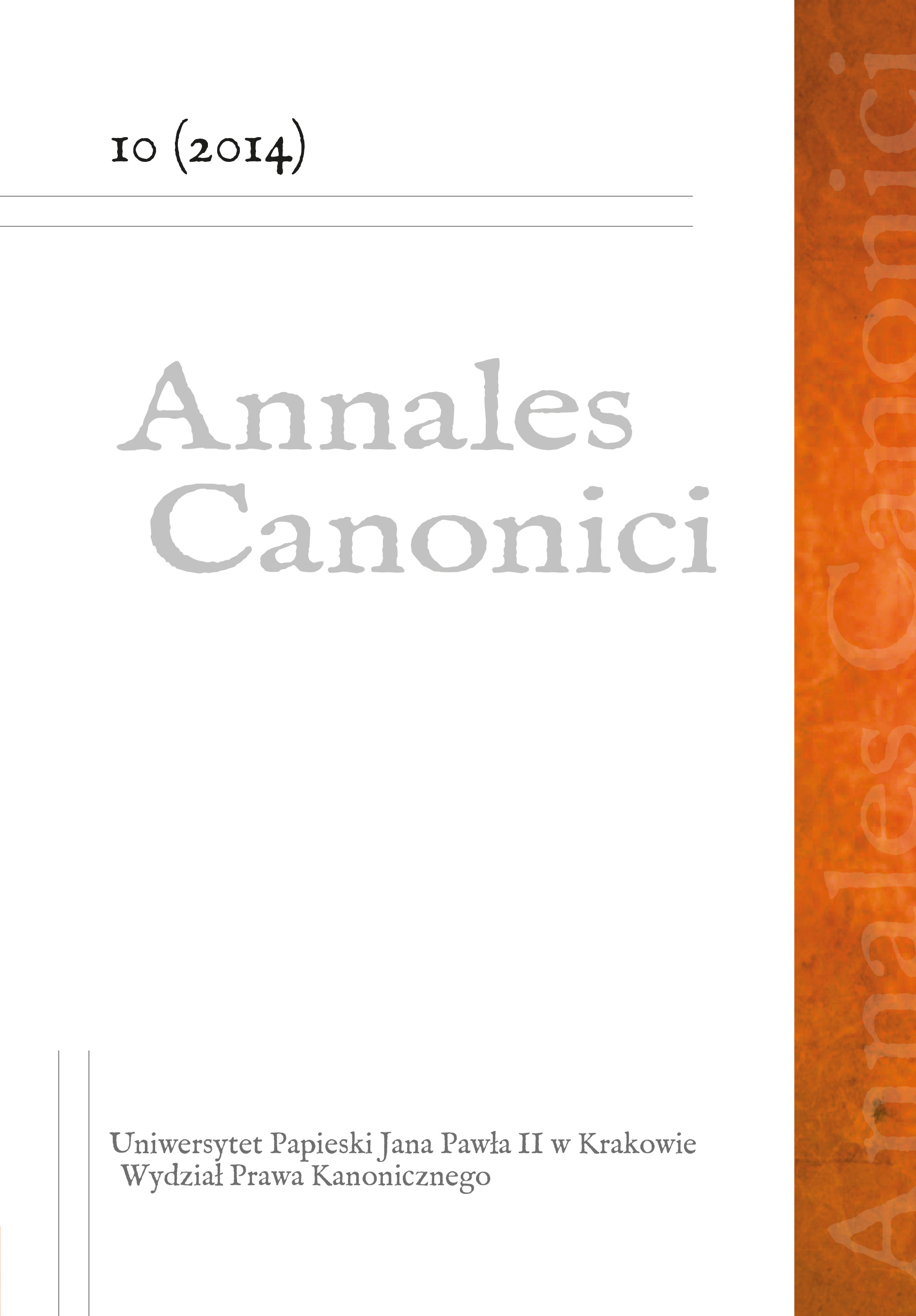Theoretical and practical problems with the five‑day deadline for application to the State Civil Registry for registering canonical marriage (art. 10 sect. 1 no. 3 of the Concordat)
DOI:
https://doi.org/10.15633/acan.1935Keywords:
Concordat, Holy See, Republic of Poland, marriage, interpretation, applicationAbstract
The Concordat between the Holy See and the Republic of Poland was signed in 1993, but ratified in 1998. Year 2013 marks the 15th anniversary of coming into effect of the bilateral agreement. It is a good opportunity to evaluate its provisions. The paper aims to present one of the pieces of evidence from art. 10 sect. 1 no. 3 of the Concordat, namely, the evidence for registering canonical marriage in the State Civil Registry so that the marriage would be a subject to such effects as a marriage contracted according to Polish law. From the interpretation of the provision in question and application of its norms there arise some theoretical and practical problems. The author tries to solve them and give some postulates de lege ferenda so as to make the law more clear.References
Góralski W., Konkordat polski 1993: od podpisania do ratyfikacji, Warszawa 1998.
Gromek K., Kodeks rodzinny i opiekuńczy. Komentarz, Warszawa 2013.
Konkordat między Stolicą Apostolską i Rzecząpospolitą Polską, podpisany w Warszawie dn. 28 lipca 1993 r. (Dz.U. z 1998 r. Nr 51, poz. 318).
Mezglewski A., Tunia A., Wyznaniowa forma zawarcia małżeństwa cywilnego, Warszawa 2007.
Postanowienie Sądu Najwyższego – Izba Cywilna z dnia 16 listopada 2005 r. (V CK 325/05), Legalis.
Prawo rodzinne w Polsce i w Europie. Zagadnienia wybrane, red. P. Kasprzyk, Lublin 2005.
Rakoczy B., Ustawa o stosunku Państwa do Kościoła Katolickiego w Polsce. Komentarz, System Informacji Prawnej LEX.
Smyczyński T., Odpowiedzialność odszkodowawcza duchownego z powodu naruszenia prawa przy zawieraniu małżeństwa, „Ruch Prawniczy, Ekonomiczny i Socjologiczny” 59 (2002) nr 2, s. 165–177.
Sobański R., Wyznaczniki kanonicznego prawa małżeńskiego, [w:] Małżeństwo w prawie świeckim i w prawie kanonicznym. Materiały Ogólnopolskiej Konferencji Naukowej zorganizowanej w dniach 12 i 13 maja 1994 roku w Katowicach, red. B. Czech, Katowice 1996, s. 183–193.
Strzebińczyk J., Zawarcie małżeństwa wyznaniowego podlegającego prawu polskiemu, „Rejent” 1999, nr 4, s. 9–41.
Ustawa z dnia 17 maja 1989 r. o stosunku Państwa do Kościoła Katolickiego w Rzeczypospolitej Polskiej (Dz.U. Nr 29, poz. 154 z późn. zm.).
Downloads
Published
Issue
Section
License
The author declares that he owns the copyright to the work (article) and that it is not limited in the scope covered by the above declaration and that the work (article) is an original work and does not infringe the copyright of other persons.
The author allows the Pontifical University of John Paul II in Krakow to use the paper free of charge, non-exclusive and unlimited in time by, i.e.:
– keeping in records and reproduction of the copies of the work using printing, reprography, magnetic recording and digital technology;
– trade in the original or copies on which the work has been recorded (introduction to the market, lending or rental of the original or copies, public exhibition, display, as well as making the work available to the public in such a way that everyone can have access to it in a place and at a time chosen by them);
– inclusion of the work in a collective work;
– granting by the Pontifical University of John Paul II in Krakow a Creative Commons Sub-licence Authorship Recognition-Non-commercial Use-No Subsidiaries 3.0 Poland
The Pontifical University of John Paul II in Krakow makes the work available on the Magazine Platform of the university under the Creative Commons Attribution-Non-commercial Use-No Subsidiary Works 3.0 Poland license.
Thus, it entitles all interested parties to use the work under the following conditions:
- the author and the title of the work will be given,
- the place of publication (journal title and internet address of the originally published work) will be indicated,
- the work will be distributed in a non-commercial manner,
- no dependent works will be created.

